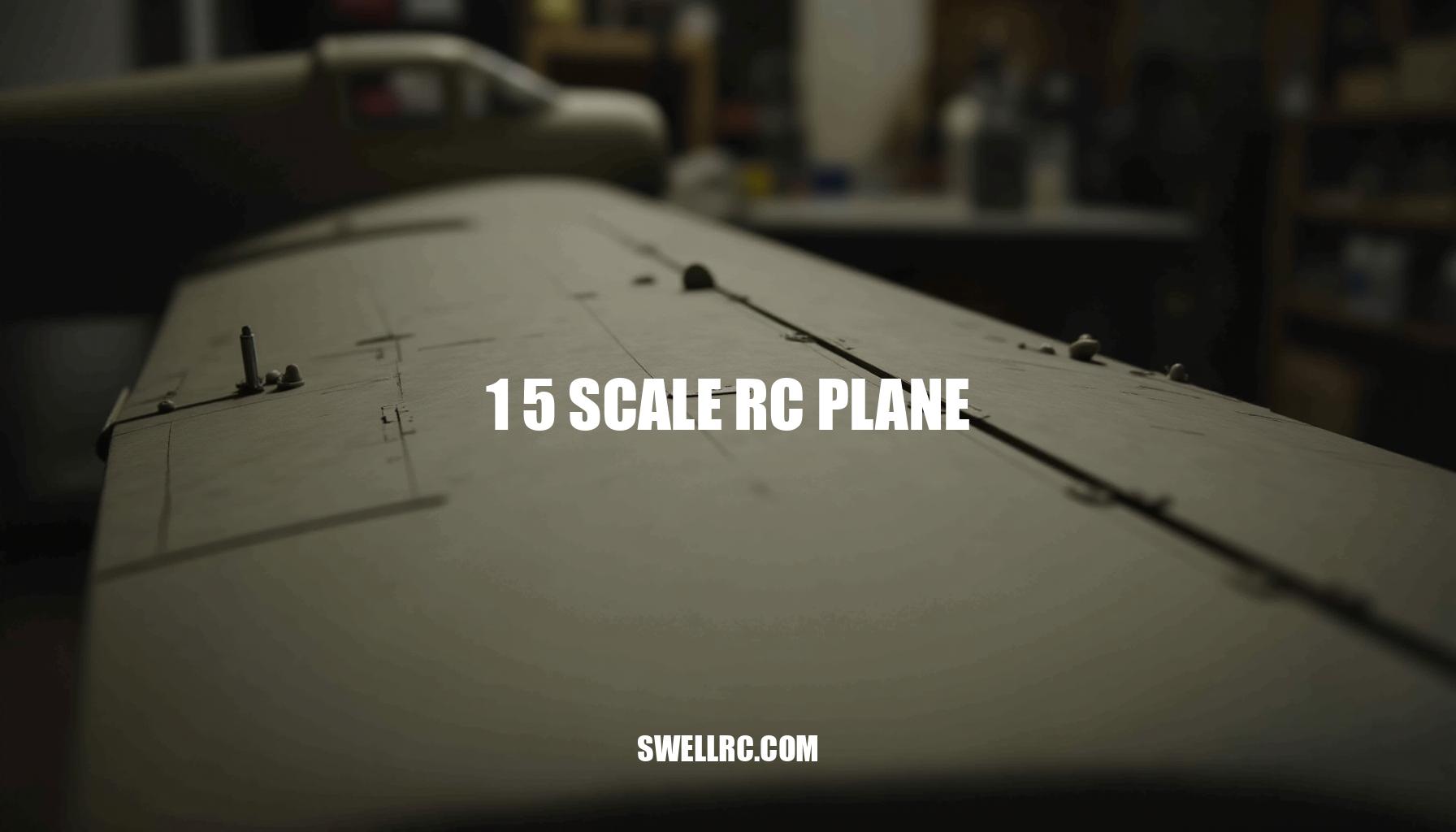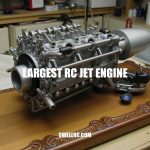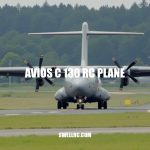The Ultimate Guide to Building and Flying a 1/5 Scale RC Plane
The first time I spooled up a 1:5 scale RC plane, the field went quiet. The prop wash ruffled my jacket, the retracts tucked in with a satisfying clunk, and the model lifted off with the authority only a giant can. That moment changed how I think about remote control flight forever.
A 1:5 scale RC airplane (often written 1:5) is a model built to one-fifth the size of the real aircraft—large enough to command presence on the ground and in the air, yet still manageable for dedicated hobbyists. Compared with smaller trainers like the AeroScout S 2 1.1M RTF, a 1:5 model amplifies everything: realism, inertia, sound, and the need for careful engineering. This blend of increased complexity and rewarding performance characterizes large-scale RC aircraft and marks a significant step up in the hobby aviation experience.
Exploring 1/5 scale RC airplane specifications reveals why these giants are so captivating.
Their giant scale RC wingspan delivers impressive stability and control, making flying a realistic challenge that mirrors real piloting nuances. The realism in large RC models extends beyond size to include intricate details in construction and powerful propulsion systems that bring remote control flight to life in unprecedented ways. Building and balancing such a model demand more precision and commitment than smaller RC airplanes, but the payoff is unparalleled satisfaction in mastering a true engineering marvel.
Whether you are transitioning from micro flyers or aiming to compare these 1:5 scale planes with even larger giants, understanding their unique qualities is key.
From component selection to flight technique, embracing the nuances of large-scale RC aircraft unlocks incredible opportunities for growth and enjoyment in hobby aviation. The journey, filled with hands-on tips and hard-earned lessons, celebrates the extraordinary joy that comes from commanding a substantial, realistic aircraft in the skies.
What Makes a 1:5 Scale RC Plane Stand Out
At 1:5, the numbers get big quickly—and so does the grin on your face. Most general aviation subjects in this scale span roughly 7–8+ feet; warbirds commonly sit in the 6–8-foot range, and big twins can go bigger still. You’ll see materials evolve from simple foam to balsa/ply structures with fiberglass RC fuselage or full composites, plus scale features like retractable landing gear for scale planes, sequenced doors, and multi-point lighting.
Servos jump to high-voltage, high-torque units; linkages get beefy; and hardware quality matters more than ever. From my testing, the payoff is rock-solid presence in the air: larger Reynolds numbers mean smoother tracking, better energy retention, and unrivaled silhouette realism.
For perspective on bigger-scale detail work, compare with a 1/3.5 project like the RC Airwolf Black Bell 222 Electric Scale 1/3.5—it shows how scale fidelity increases as models grow, and why 1:5 sits in a sweet spot of manageability and immersion. Below is a comparison snapshot illustrating how giant scale RC wingspan, complexity, and systems evolve as you move from sub-250g foam models up to 1:3.5 giants featuring large electric RC motor setup and heavy composite use. Understanding the difference between 1/5 and 1/3.5 RC plane scales will help you choose the right project based on desired detail, transport logistics, and flight characteristics.
| Scale | Typical Wingspan | Construction Materials | Features & Systems | Weight | Transport & Handling |
|---|---|---|---|---|---|
| 1:5 | 6–9 ft (giant scale RC wingspan) | Balsa/Ply + fiberglass RC fuselage/composite | Retractable landing gear for scale planes common, multi-point lighting, sequenced doors | 8–20+ kg | Usually manageable without trailer |
| 1:3.5 | 8–12 ft | Heavy composite use | Complex systems, highly detailed, advanced electronics | Heavier than 1:5 | Trailer transport likely required |
| Sub-250g | Varies (miniature) | Foam/Carbon fiber | Hand-launch capable, minimalist gear | <250 grams | Park-friendly, ultra-portable |
If your dream is cockpit-detail realism and confident, scale-like flight, 1:5 delivers it without always needing a dedicated trailer. Brands like World Models RC planes often highlight this scale for blending immersive experience with practical handling. Whether you’re looking at upgrades such as a large electric RC motor setup or upgrading to a fiberglass RC fuselage for durability and scale accuracy, 1:5 is a sweet spot between manageable size and outstanding presence in the sky.
Choosing the Perfect Components and Power System
Powering a 1:5 scale RC aircraft effectively requires a careful balance of thrust, weight, endurance, and thermal headroom to ensure reliable and enjoyable flights. One of the best motor options for a 1/5 RC aircraft is selected by considering the power-to-weight ratio, typically around 120–150 W/lb for realistic scale flying or up to 180–220 W/lb for more spirited aerobatics. For instance, a 30–40 lb model aims for approximately 3.6–8.8 kW output to meet performance expectations.
The thrust-to-weight ratio is a crucial parameter to evaluate; stately scale flying benefits from a ratio around 0.7–0.9, whereas aggressive maneuvers demand close to 1:1 for vertical reserve. This balance ensures the aircraft handles well during climbs and aerobatics.
Determining what battery size to use for a 1/5 scale RC plane is equally important. Common setups utilize 10S–14S LiPo or Li-ion battery packs with capacities typically ranging from 10,000 to 16,000 mAh, sometimes connected in parallel to optimize flight duration while keeping current draw manageable. This large electric RC motor setup ensures sufficient energy density without compromising weight distribution.
When choosing the ESC and wiring, it’s key to select components rated for continuous current with a 20–30% safety margin. Adequate cooling and connector ratings must be verified to prevent failures under high loads. Improper ESC sizing or overspinning a large propeller can cause overheating and damage.
Prop selection ties directly into motor and battery choices. Aggressive propeller pitch or diameter can induce current spikes, especially on takeoff, so bench testing the largest prop intended for use is essential. Adjusting the pitch, diameter, or increasing cell count can help keep amperage within safe limits.
Balancing the aircraft is another critical factor. Most 1/5 scale designs have their center of gravity (CG) at 25–33% of the mean aerodynamic chord (MAC). Proper battery placement can fine-tune the CG to avoid adding unwanted ballast.
Additionally, maintaining lateral balance is vital, as heavy wingtips can exacerbate roll trim problems.
Reinforcement is recommended for motor boxes, firewall joints, and landing gear mounts, given that torque and landing stresses scale significantly at this size.
For comparison, gas engines in the 50–80cc category remain popular for 1:5 warbirds and classic models, offering long flights, delightful engine sounds, and straightforward refueling. On the other hand, electric powertrains provide instant torque, cleaner installations, and precise throttle control, albeit with more demanding battery and power electronics management.
For detailed guidance on ESC sizing, prop selection, and how to balance a giant scale RC airplane, resources like How to Size Electric Motor for RC Airplane offer methodical approaches and propeller logic. Observing large multi-motor projects like the Avios C-130 RC Plane or premium composite models such as those from the CARF RC planes lineup can provide valuable real-world insights into system complexity and scaling challenges.
Building and Customizing Your Own 1:5 Scale RC Aircraft
When building a 1/5 scale RC airplane, craftsmanship and meticulous planning are crucial to achieving a model that not only looks authentic but also performs reliably. My build flow reads like a workshop diary and covers every essential step for success.
Plan: Choose the subject and power system first, then confirm transport and storage arrangements to accommodate the large airframe.
Source: Acquire quality components such as the airframe kit or detailed plans, reliable retractable landing gear for scale planes, sturdy struts, high-torque servos (20–45 kg-cm HV), durable hinges, precise linkages, the ESC or engine, batteries or fuel tank, and wiring hardware.
Dry fit: Test gear doors and retract angles meticulously, and check servo geometry before gluing. These checks prevent common issues like binding or misalignment later in the build.
Structure: Reinforce high-stress zones including the firewall, wing joiner, retract mounts, and tail post with carbon fiber or plywood doublers.
Incorporating a fiberglass RC fuselage can enhance strength while keeping weight manageable.
Systems install: Keep wiring short and neat; isolate signal leads from power lines to reduce interference. Verify failsafes and redundancy especially for ignition systems or BEC to ensure reliability.
Finish and scale detail: Apply lightweight glassing techniques, then add panel lines, rivets, and weathering effects. Balance the beauty of the model against grams—remember that paint adds weight quickly and effective weight management is vital.
Weigh and balance: Achieve the correct center of gravity (CG) without ballast, verify control throws and rates, and perform a power-on range check to fine-tune performance.
Throughout the build process, I have encountered common pitfalls that are instructive for anyone involved in troubleshooting RC builds:
- Nose gear alignment off by even a degree or two, causing unwanted runway wander during takeoff and landing.
- Retract doors binding under load, which requires sanding, sealing, and precise hinging to ensure smooth operation.
- Over-applying paint and primer, which adds unnecessary weight; finish weights must be measured carefully.
- Forgetting vibration mitigation on fuel-powered builds; using threadlock, safety wire, and isolation mounts is essential to prevent loosening or damage.
The payoff for attention to detail and expert craftsmanship is enormous: a custom 1:5 model that flies like it looks—credible, confident, and truly a testament to skill in building a 1/5 scale RC airplane.
For those interested in how this contrasts with smaller projects, techniques for crafting super light RC indoor planes can be enlightening (explore here).
Flight Experience and Real-world Impressions
Flying a 1:5 scale RC plane truly engages every sense, creating an immersive experience that goes beyond typical remote control flight. You can feel the mass of the model during rollout, hear the distinct sound of blade tips ripping through the air on a powerful pass, and watch as the plane skillfully carves through wind conditions that would easily disrupt smaller aircraft. To optimize performance and enhance realism in large RC models, I typically adjust the rates—setting low rates for a smooth liftoff, mid rates for steady circuit flying, and high rates ready for challenging go-arounds.
When balanced correctly, the airplane tracks like it’s on rails, making maneuvers precise and predictable. The visual scale details, such as gear cycles, flap deployments, and slow approach speeds, not only boost authenticity but also attract attention during each flight. Compared with lighter sub-250g RC planes, a 1:5 scale model offers a calmer experience in turbulence, deliberate rolls, and superior energy retention through maneuvers—emphasizing the importance of stall discipline and thorough landing planning.
For that coveted “airshow” aura, I often draw inspiration from larger subjects, like the iconic Boeing 747 RC Plane. Even if your model is smaller, incorporating similar approach and landing techniques, especially flawless flap management, contributes greatly to flying realism.
Maintenance for giant scale RC models is integral to the flying rhythm and cannot be overlooked. Routine post-flight checks including bolt tightening, gear inspections, and thorough battery care (if operating electric-powered models) ensure reliability and longevity. The ultimate reward comes when your scale model not only looks authentic but consistently flies the part, delivering an unparalleled remote control flight experience.
Comparing Scales — Why Size Truly Matters
Scale drives everything in the world of RC aircraft—presence, handling, cost, and logistics all hinge on size. Understanding the difference between 1/5 and 1/3.5 RC plane scales is essential for enthusiasts weighing their options. Below is a breakdown from my field notes highlighting common tiers and their respective characteristics:
| Scale | Wingspan | Weight | Power System | Transport & Logistics | Additional Notes |
|---|---|---|---|---|---|
| 1:5 Scale | 6–9 ft | 8–20+ kg | 10S–14S Electric or 50–80cc Gas | Retracts common; transport in SUV/van with removable wings | Giant scale RC wingspan demands robust linkages & landing gear |
| 1:3.5 Scale | 8–12 ft | Likely composite | Multi-pack electric or gas | Routine trailer transport | Advanced build and field support; precise systems escalate load capacity |
| 1:10 and Similar | 3–4 ft | – | Affordable electronics | Convenient to transport | Forgiving handling; ideal for skill progression |
| Micros/Sub-250g | Palm-light | Under 250g | – | Fly almost anywhere | Minimal inertia; excellent for practice and experimentation |
When discussing logistics for giant RC aircraft, one must consider transportation and storage nuances unique to larger scales. The cross-scale comparison not only clarifies these challenges but also highlights how engineering components such as linkages, bearings, landing gear, and power systems evolve markedly between sizes.
Drawing a cross-hobby perspective is illuminating; for instance, upgrading from smaller RC cars to 1/5 scale introduces noticeable changes in precision and durability, much like stepping up from smaller RC aircraft to giant scale models. Brand ecosystems that cover multiple sizes facilitate a smoother upgrade path, allowing pilots to evaluate airframes and parts availability across ranges before delving into a large-scale build.
For a detailed look at similar scale differences across RC hobbies, check out this link on 1/5 scale RC cars, which vividly illustrates the jump in engineering and presence comparable to giant scale RC aircraft.
Conclusion: Why the 1:5 Scale is the Ultimate RC Experience
After years of tinkering, testing, and plenty of humble learning, I keep coming back to 1:5 scale as the sweet spot for hobby aviation. It’s where craftsmanship and pride truly come together: big enough to look and fly like the real thing—capturing the essence of scale realism—yet small enough to transport without a dedicated rig. This balance strikes a chord within the RC airplanes community, offering a rewarding experience for enthusiasts focused on large-scale RC aircraft.
The engineering challenge at this scale is meaningful. Power, structure, and balance must harmonize to ensure a smooth flight, making each takeoff a proud moment when the wheels leave the runway. If you’re ready to deepen your journey into model aviation, explore a variety of subjects and brands for inspiration.
A great starting point is the diverse range highlighted in World Models RC planes, which showcases both craftsmanship and the joy of flying.
- Discover detailed large-scale RC aircraft designs.
- Engage with a passionate RC airplanes community.
- Experience true scale realism in every model flight.
- Learn the delicate balance of power and structure.
- Celebrate the pride that comes with expert craftsmanship.
Bring your curiosity, patience, and passion for flight—1:5 scale models will meet you there with unforgettable moments that celebrate the art and science of hobby aviation.
Frequently Asked Questions
- What is the wingspan of a 1/5 scale RC plane?
It depends on the full-size subject. Take one-fifth of the real aircraft’s span. Typical examples: a Cessna 182 (≈36 ft full-scale) yields about 7.2 ft; many WWII fighters (≈30–40 ft) land in the 6–8 ft range; large twins and transports can exceed 8 ft. - How powerful should the motor be for a 1/5 scale RC airplane?
Plan by weight and mission. Aim for about 120–150 W/lb for scale flying and 180–220 W/lb for aerobatics. For a 30–40 lb model, that’s roughly 3.6–8.8 kW. Electric setups often use 10S–14S with a properly rated ESC; gas engines in the 50–80cc class are common alternatives. - Is a 1/5 scale RC plane suitable for beginners?
Not typically. The size, mass, and energy require experience with setup, preflight, and landing discipline. Beginners should start with smaller trainers, then step up. A supervised path with instructor support and simulator practice is the safest route. - What materials are best for building a 1/5 scale RC aircraft?
Balsa/ply structures with fiberglass skinning are common, while high-end models use full composites and carbon reinforcement. Prioritize strong retract mounts, robust control linkages, and high-torque HV servos. Choose materials that balance stiffness, durability, and weight. - How do you transport and store a giant RC plane safely?
Use wing bags and padded cradles, remove wings/stabs when possible, and secure the fuselage with soft straps. Transport in an SUV/van or trailer with tie-down points. Store in a dry, climate-stable space, and follow safe LiPo practices for electric setups. - How does a 1/5 scale RC plane compare to other large-scale models like the Avios C-130 RC Plane?
Both are large and immersive, but a 1/5 single or twin is usually heavier, more complex structurally, and may demand higher-power systems. A multi-motor foam model like the Avios C-130 emphasizes convenience and system integration, whereas many 1/5 builds focus on custom structure, retracts, and scale detailing.



